Content
Published:
This is an archived release.
Downturn continues in manufacturing
Norwegian industrial managers report a further downturn in the total output in the third quarter of 2015. Weak figures from producers of capital goods explain much of the downturn. Expectations for the fourth quarter are negative in much of manufacturing. Declining orders from both the domestic and export market support these findings.
| 3rd quarter 2015 | ||
|---|---|---|
| Changes from previous quarter | Expected changes in next quarter | |
| 1A diffusion index is compiled using the estimated percentages on "ups" and "same" according to the formula: (ups + 0,5 * same). The diffusion index has a turning point at 50. An index value above 50 indicates growth in the variable, and opposite for a value below 50. | ||
| Total volume of production | 47.5 | 45.2 |
| Average capacity utilisation | 47.3 | 44.4 |
| Average employment | 39.3 | 35.5 |
| New orders received from home markets | 43.3 | 44.2 |
| New orders received from export markets | 43.1 | 44.5 |
| Total stock of orders | 43.3 | 42.6 |
| Prices on products at home markets | 50.2 | 50.2 |
| Prices on products at export markets | 49.0 | 46.7 |
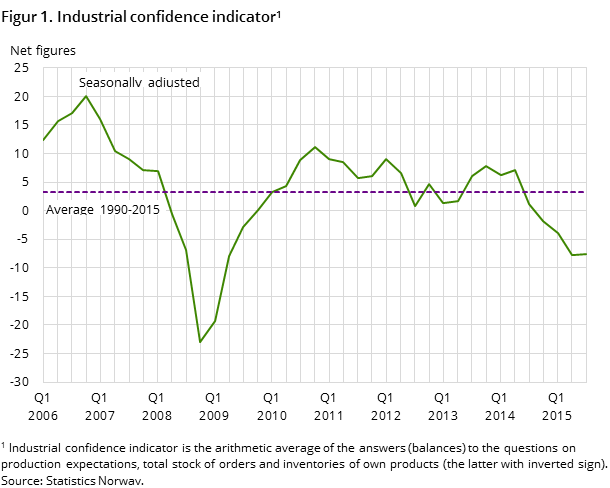
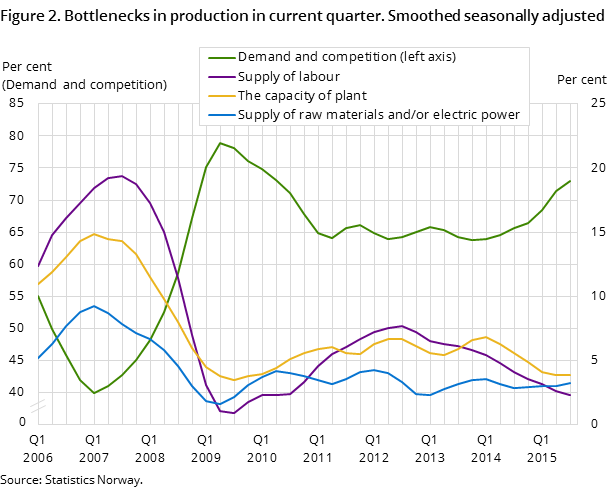
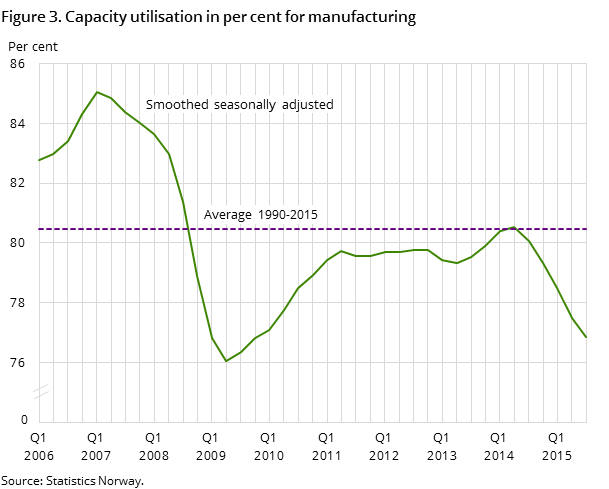
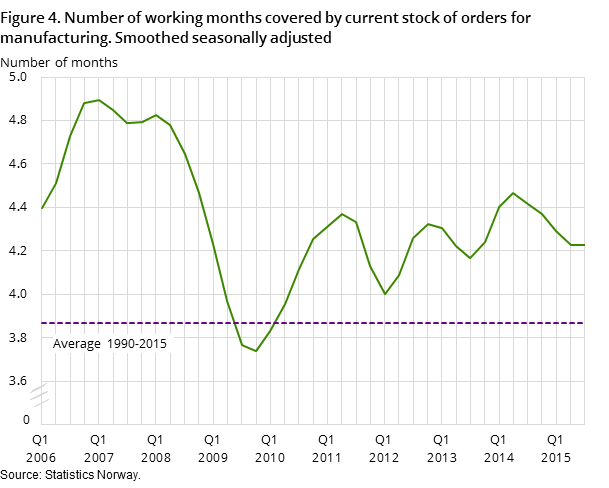
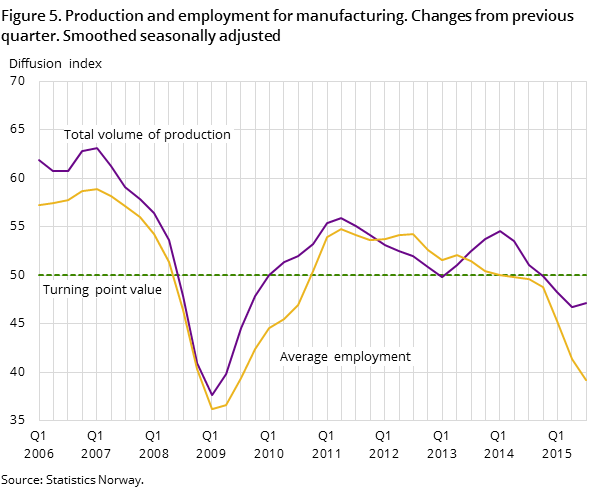
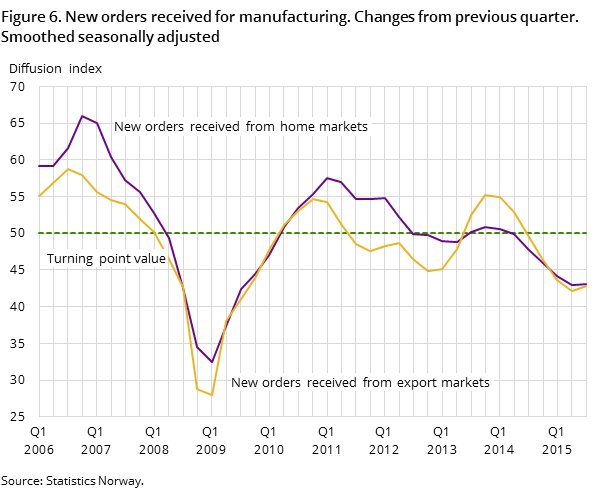
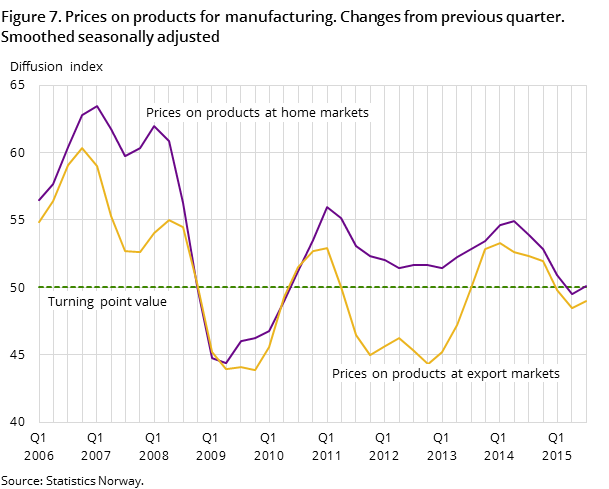
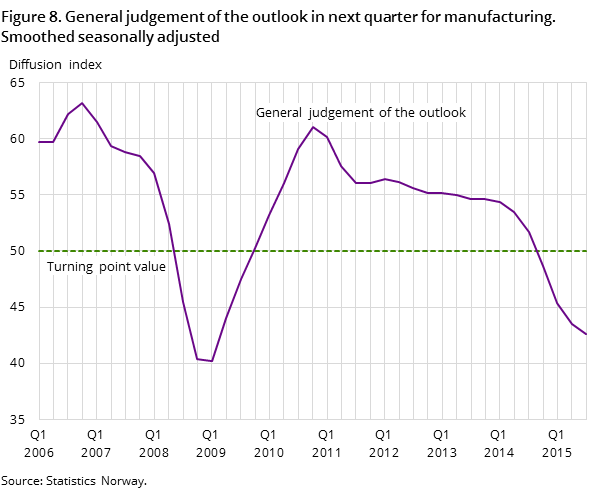
The business tendency survey for the third quarter of 2015 shows a downturn in total production compared with the second quarter. An increasing share of industrial managers is highlighting weak demand and strong competition as factors that limit production. However, there is still no increasing strength on the decline and the share of industrial managers who are negative to the development in production is about the same as in the previous survey. The results from manufacturers of capital goods are still the weakest. This contributes to a continuation of the negative trend in industrial production that began in late 2014. The fall was particularly due to a lower level of activity among suppliers to the oil and gas sector. Industries such as machinery and equipment, building of ships, boats and oil platforms, and repair and installation of machinery all faced a decline in production. The index of industrial production also showed a clear decline in production for manufacturing at the start of the third quarter.
Intermediate goods, however, saw an increase in production volume in the third quarter of 2015. These producers, which include traditional export industries, report increased production in most of the manufacturing divisions. In particular, this applies to basic chemicals, wood and wood products and non-ferrous metals. Within consumer goods the production is basically unchanged.
The overall employment declined in the third quarter of 2015. The decrease emanates from producers in all three main industrial groupings, but is most pronounced in investment goods.
Reduced orders and decline in total stock of orders
The total stock of orders in manufacturing declined in the third quarter. There was also a downturn in new orders from both the domestic and the export market. The decline in new orders is particularly related to producers of capital goods where suppliers to the oil and gas sector are the main contributors: building of ships, boats and oil platforms and machinery and equipment together with repair and installation of machinery.
Producers of intermediate goods also had a decline in new orders, while the total stock of orders was almost unchanged from the previous quarter. Traditional export-oriented industries such as non-ferrous metals experienced an increase in new orders, but a clear drop in prices. For manufacturers of consumer goods there was an increase in the stock of orders, while new orders from the domestic market were negative for the first time since the second quarter of 2009.
For manufacturers of capital goods the prices fell for products in both the domestic and export market. Intermediate goods saw a fall in export prices, while the home market was mainly unchanged. For consumer goods there was an increase in prices in both markets.
Pending decline in the fourth quarter of 2015
The general outlook for the fourth quarter of 2015 is negative, and is at its lowest level since the first quarter of 2009. Investment plans are adjusted downward. Lower investment activity in the oil and gas sector accounts for much of the decline in investment plans, as there is considerable excess capacity among producers of these goods. A general fall in employment and the stock of orders is also expected. Manufacturers of capital goods are negative in relation to the fourth quarter, and producers of intermediate goods are somewhat pessimistic about the future. Manufacturers of consumer goods are more optimistic, mainly due to optimism among producers of food and food products.
The industrial confidence indicator in the third quarter was at the same level as the previous quarter, at -8 (seasonally-adjusted net figures). This is still below the historical average of 3. Producers of investment goods pulled down the confidence indicator, with a fall from -18 to -20 from the second to the third quarter. Values above zero indicate that total output will grow, while values below zero indicate that total output will fall. International comparisons of the industrial confidence indicator are available from Eurostat (EU), The Swedish National Institute of Economic Research and Statistics Denmark.
Declining capacity utilisation in manufacturing
Average capacity utilisation for Norwegian manufacturing was calculated to 76.8 per cent at the end of the third quarter of 2015. This is the lowest level recorded since the third quarter of 2009, and the result is below the historical average of 80.5 per cent. International comparisons of average capacity utilisation are available from Eurostat (EU).
The average number of working months covered by the current stock of orders was 4.2 months in the third quarter of 2015. This is somewhat down from the last quarter but still above the historical average of 3.9 months. The indicator on resource shortage is also down in the third quarter. This is due to an improvement in the shortage of labour supply and a fall in the number reporting full capacity utilisation.
Timeliness
The survey data was collected in the period from 10 September 2015 to 25 October 2015.
Assessment of Q3 2015 and the short-term outlook¹
1 An overall evaluation of the present situation and expected short-term developments. 2 Very good: ++, Good: +, Stable: ~, Poor: -, Very poor: --, Good, but with certain negative indications: +(-), A situation where the + and - factors even out: +/-, Poor, but with certain positive indications: -(+) | |
| Industry | Evaluation 2 |
| Food, beverages and tobacco | + |
| Wood and wood products | + |
| Paper and paper products | +(-) |
| Basic chemicals | -(+) |
| Non-ferrous metals | -(+) |
| Fabricated metal products | - |
| Computer and electrical equipment | - |
| Machinery and equipment | -- |
| Ships, boats and oil platforms | -- |
| Repair, installation of machinery | -- |
Additional information
The statistics provide current data on the business cycle for manufacturing, mining and quarrying by collecting business leaders’ assessments of the economic situation and the short term outlook.
Contact
-
Edvard Andreassen
E-mail: edvard.andreassen@ssb.no
tel.: (+47) 40 90 23 32
-
Ståle Mæland
E-mail: stale.maeland@ssb.no
tel.: (+47) 95 05 98 88
